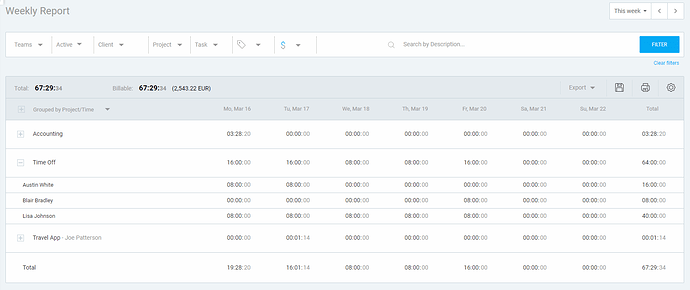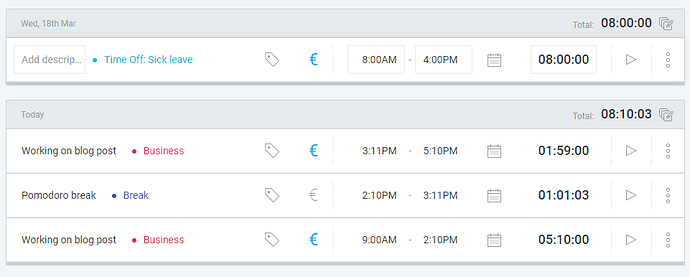How you’ll track time off will depend on how you organize your data and use reports. If you want to differentiate between types of leave in the report, it might be best to create a separate project for each type.
If you want to see all absences as one, you can have one project “Time off” and use tasks to differentiate between them.
General Time Off
The easiest way to do this is to simply create a project and call it “Time Off” then make it public so all users in your workspace can have access to it.
Additionally, you can add tasks to this project such as Sick leave, Holidays, Vacation, Unpaid leave, etc. to further classify what type of PTO this is. Or you can set them up as separate projects.
This way, your staff can log their time off days by creating 8h-long (or however long is their typical workday) time entries on that “Time Off” project.
If someone decides to cancel their time off, they can simply delete the entry. Or, even better, notify the admin about the change so the admin can delete it for them.
Holidays
If you wish to designate public holidays so people can see that they don’t need to track time on these dates, you can add the time for your team on those days yourself (Adding time for others is a Premium feature).
Simply go to Detailed report, add time for the team, choose a “Time Off” project, add holiday note or select a Holiday task if you have one, select team members (all or some specific), and Add.
Unpaid Leave
If you set Unpaid Leave as a separate project, you can mark it as non-billable so when users track time on this project their time entries will be non-billable by default.
If you track it as a task under project “Time Off”, then a person adding time to Unpaid Leave task can just mark their time entry as non-billable manually.
Running reports on "Time off"
Now when you run your reports, you can see who was away, how long, and how much time they used up.
One of the options is to run the Weekly report and see who’s absent and when.
Also, your team can check how many vacation days they have left. All they have to do is run a Summary report and filter the data.
They can see how much time they’ve logged for time off and divide it by 8 to get the number of used-up vacation days.
If you’d like, you can check out our blog post on How to track your team’s vacations and time off to get more details.
Breaks
Similarly to tracking time off, one option is to make a project and name it “Break”, make it billable or non-billable depending if it’s a paid break time or not.
Now your employees can log their breaks by creating time entries on that “Break” project.
Another option is to create a “break” tag and have people mark their entries with this tag. Just create a 30 minutes time entry in the Time tracker, leave it without a project, mark as billable or non-billable, and attach “break” tag.
Breaks with Pomodoro and Idle detection feature
You can also install Clockify browser extension or macOS desktop app and use Idle time detection or Pomodoro feature.
When Idle time feature is active Clockify can detect if you leave a timer running when you leave your desk, and let you remove the idle time so your timesheets stay accurate.
So you can go to their lunch break and the idle time will get activated, then once you come back you will be able to choose if you want to discard the idle time or to keep it.
You can also track breaks with the Pomodoro feature. Set a work time interval and a break interval so when your work time is up you’ll be notified it’s time to take a break.
You can start this break from the notification and when your break time is over you’ll get another notification to start working again and you can start the timer on your latest entry.
The break time will be automatically added with the “Pomodoro break” description.


